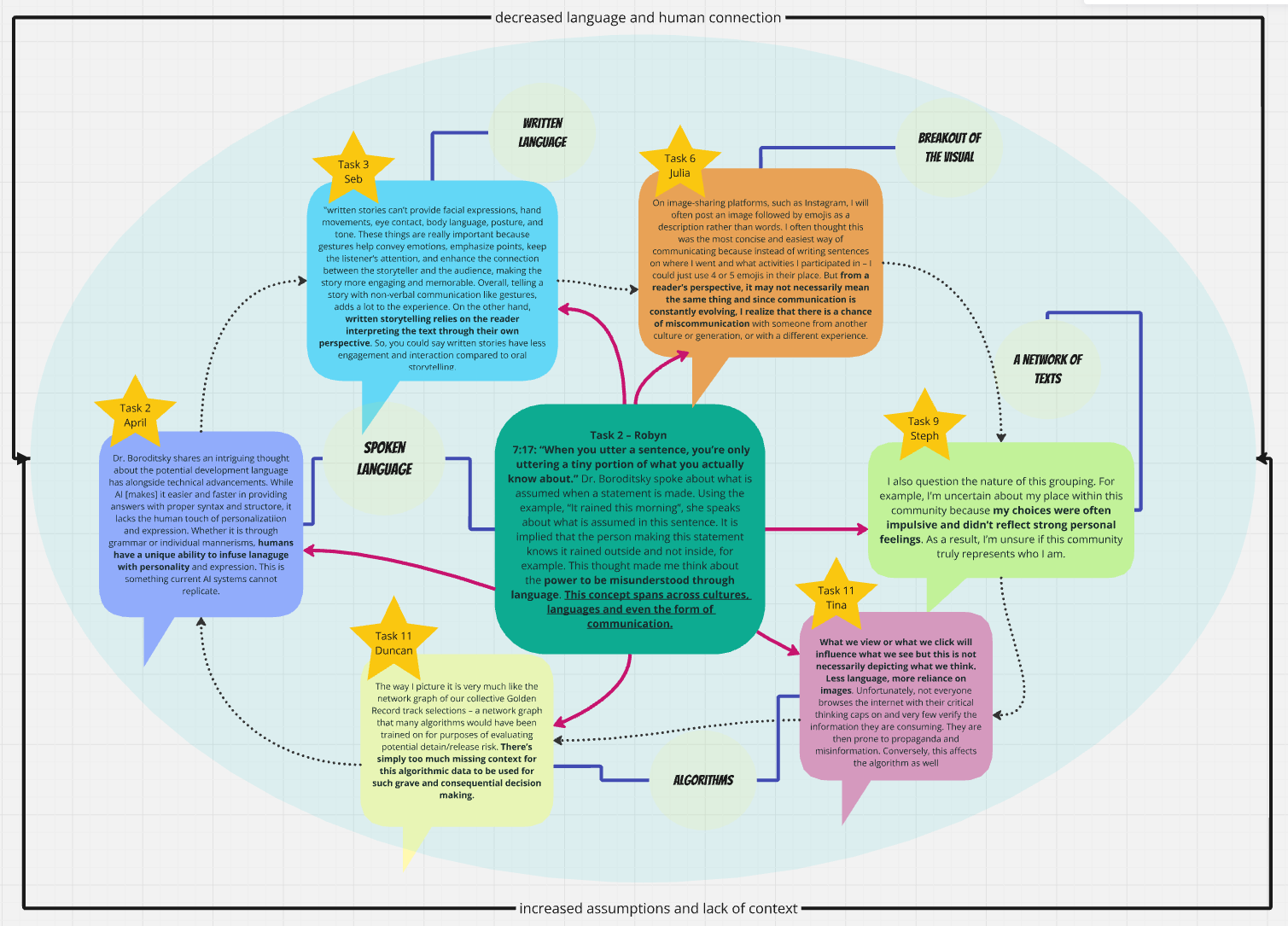
For this assignment, I chose to represent the links I have made throughout this course in a mind map. One of my key takeaways is the complexity of text and technology, which is difficult to summarize. It is not simply if A, then B; there is a web of links between each module in addition to my classmates’ interpretations of the content. This mind map allowed me to visualize the posts that resonated with me and showcase how they align. As I took a step back, what stood out to me was the progression of language and communication throughout history. At the beginning of this course, I was struck by Dr Boroditsky’s lecture at the School for Advanced Research (2017) and how spoken language can shape thought. Up until this point, I had always thought of language as the clearest form of communication; however, this lecture planted a seed that I would carry through this course and provided me with an alternate lens to examine how we communicate, specifically regarding text and technology.
The blog posts that resonated with me shared a commonality: as our technology has advanced, what are we losing? Seb (Seo, 2024) reflects on what is lost in written language. Facial expressions, hand movements, eye contact, and body language, to name a few. Seb (Seo, 2024) notes how human gestures convey emotions and enhance connection. As we transition to the breakout of the visual, Julia (Cheong, 2024) reflects on how an image may appear to be the most concise and easiest way of communication; however, there is a potential for miscommunication depending on culture or generation. Advancing to a network of texts, Steph (Takeda, 2024) noted how online data may not truly represent who we are. “My choices were often impulsive and didn’t reflect strong personal feelings,” highlighting the potential misinterpretation of our online footprint. Tina (Wei, n.d.) furthers this point when she acknowledges that what we view and click does not necessarily depict what we think. “Less language, more reliance on images” (Wei, n.d.).
At this point I found myself asking the following question: Is our spoken language and ability to communicate being compromised or potentially lost as our technology advances? This question is further amplified as we begin to think about artificial intelligence. “There’s simply too much missing context for this algorithmic data to be used for such grave and consequential decision-making” (Hamilton, 2024). As we move away from conversational language, what is lost? April’s task 2 post brings us full circle as she had intuitively foreshadowed the final modules of this course with her reflection on Dr Boroditsky’s lecture. April notes that although AI has advantages, there is a lack of human touch, personalization and expression (Huang, 2024). “Humans have a unique ability to infuse language with personality and expression, and this is something that AI systems cannot replicate” (Huang, 2024).
Are we losing something or gaining something with technology? I am not sure this question can be definitively answered, but it reminds me of a quote by Dr. Boroditsky that captures the essence of this reflection. “People are always using language in new ways; language has never been static; it is a living thing” (SAR, 2017).
References
Cheong, J. (2024, June 23). Task 6: An emoji story. UBC Blogs. https://blogs.ubc.ca/stephtakeda/2024/07/16/task-9-network-assignment/
Hamilton, D (2024, July 21). Task 11 – Detain/Release. UBC Blogs. https://blogs.ubc.ca/duncman/2024/07/21/task-11-detain-release/
Huang, A. (2024, June 1). Task 2: How language shapes the way we think. UBC Blogs. https://blogs.ubc.ca/etec540ah/2024/06/01/task-2-how-languages-shape-the-way-we-think/
Seo, S. (2024, June 2). Task 3: Voice to text task. UBC Blogs. https://blogs.ubc.ca/etec540sebsspace/2024/06/02/task-3-voice-to-text-task/
Takeda, S. (2024, July 16). Task 9: Network assignment. UBC Blogs. https://blogs.ubc.ca/stephtakeda/2024/07/16/task-9-network-assignment/
SAR School for Advanced Research. (2017, June 7). Lera Boroditsky, how the languages we speak shape the way we think [Video]. YouTube.
Wei, T. (n.d.) Task 11. UBC Blogs. https://blogs.ubc.ca/thisisthewei/task-11/
